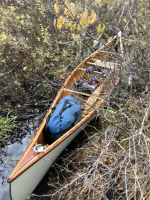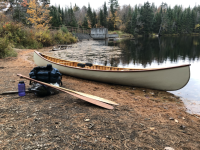A partial solo transit of the Whitney Wilderness 'Loop'; starting from the DEC headquarters on Little Tupper Lake and traveling around 32 miles to Low's Lower Dam take out on the Bog River Flow. Also, this would be the first overnight canoe trip for the Island Falls Willow solo canoe I restored almost exactly one year prior.
Day 1: The Marathon- October 8, 2022
I like road trips. I especially like trips heading north to the Adirondacks and New England where I've spent so much of my life hiking, climbing, camping, and canoeing. As has become my habit, I rose early and left home precisely at 4:00am with roughly 8 hours of driving ahead of me. I had loaded my canoe and gear in the truck the evening before and needed only to drag myself out of bed and get moving.

An uneventful ride brought me to Exit 20 on the Adirondack Northway where, for me, the fun starts. The familiar sights of the rising foothills of the Adirondack mountains raised my excitement level on the roadway I had first travelled in 1967, shortly after the road opened, on the way to Expo '67 in Montreal.

 www.newyorkalmanack.com
www.newyorkalmanack.com
Soon I was heading off to the northwest through little villages dressed in perfect Fall foliage, and finally arriving in good time by 11:15am at the Little Tupper Lake DEC headquarters to drop off my canoe near the launch site. I still had lots to do prior to pushing off into Little Tupper Lake. I unloaded and left my canoe, paddles, & gear cable-locked behind the sign in board, and then drove 13.5 miles over to the Low's Lower Dam parking lot where I would leave my truck. There, I pulled out my bike and briskly pedalled back to the canoe, arriving at 1:30pm, ready to go. Unfortunately, I had made two mistakes: in my haste to begin pedaling, I left my sunglasses in the truck even though I had purposefully set the case on the dashboard so I wouldn't forget them. This error would come back to haunt me later, and secondly, I forgot to lock the truck! Fortunately the truck was never disturbed in my absence!

I signed in to the register, noticing that our fellow forum member RickR had been there just the day before- small world! After carrying the canoe and gear down to the sandy beach landing,

I set off directly into a stiff westerly headwind which was to dog me the entire way to Rock Creek, the outlet of Rock Pond, my intended destination for the day. Leapfrogging from islet to islet along the south shore to minimize the headwind I finally arrived with relief at Rock Creek where the wind was reduced. Here I encountered the first of many beaver dams to come on this trip. My lightweight little canoe was easy to drag over the dam.

I thoroughly enjoyed the transit of Rock Creek, and the short carry leading to Rock Pond, and as the evening was nearing I paddled on hoping to set up at site 26, nearest to the carry to Hardigan Pond. Unfortunately, while the rocky landing was picturesque, the site itself was a dismal, tiny clearing hacked out of the woods- not a level spot in sight for my tent.

Disappointed, I made the quick decision to go for the carry to Hardigan Pond despite the fact that it was already 5:30pm with the prospect of dusk arriving soon. The carry to Hardigan has the reputation of being wet & arduous and I found that to be accurate! Consequently, I didn't take any photos and did my best to make good time with the little light I had. Unfortunately I had to don my headlamp to follow the path and had some trouble finding my way when the path made turns onto an old logging road. I nearly went off-trail several times and had to backtrack to find the way in the gloom. Eventually I made it to the small but adequate site on Hardigan Pond, though I didn't have the energy to go back and finish carrying the canoe from where I had left it at the end of the last boggy bit. That could wait for morning! I quickly set up my tent, made a bit of supper, and gratefully got in the sack at about 8:30pm- seen here the next morning.

Totals for my marathon day: 412 miles in the truck; 13.5 miles on the bike; 7 miles by canoe; 1.8 miles on foot; 15 hours continuously on the move!
Day 1: The Marathon- October 8, 2022
I like road trips. I especially like trips heading north to the Adirondacks and New England where I've spent so much of my life hiking, climbing, camping, and canoeing. As has become my habit, I rose early and left home precisely at 4:00am with roughly 8 hours of driving ahead of me. I had loaded my canoe and gear in the truck the evening before and needed only to drag myself out of bed and get moving.

An uneventful ride brought me to Exit 20 on the Adirondack Northway where, for me, the fun starts. The familiar sights of the rising foothills of the Adirondack mountains raised my excitement level on the roadway I had first travelled in 1967, shortly after the road opened, on the way to Expo '67 in Montreal.

The Adirondack Northway: Some History - New York Almanack
The Adirondack Northway (I-87) made Lake George more accessible than any other resort area in the Northeast. So, it’s appropriate that the birth of the modern
 www.newyorkalmanack.com
www.newyorkalmanack.com
Soon I was heading off to the northwest through little villages dressed in perfect Fall foliage, and finally arriving in good time by 11:15am at the Little Tupper Lake DEC headquarters to drop off my canoe near the launch site. I still had lots to do prior to pushing off into Little Tupper Lake. I unloaded and left my canoe, paddles, & gear cable-locked behind the sign in board, and then drove 13.5 miles over to the Low's Lower Dam parking lot where I would leave my truck. There, I pulled out my bike and briskly pedalled back to the canoe, arriving at 1:30pm, ready to go. Unfortunately, I had made two mistakes: in my haste to begin pedaling, I left my sunglasses in the truck even though I had purposefully set the case on the dashboard so I wouldn't forget them. This error would come back to haunt me later, and secondly, I forgot to lock the truck! Fortunately the truck was never disturbed in my absence!

I signed in to the register, noticing that our fellow forum member RickR had been there just the day before- small world! After carrying the canoe and gear down to the sandy beach landing,

I set off directly into a stiff westerly headwind which was to dog me the entire way to Rock Creek, the outlet of Rock Pond, my intended destination for the day. Leapfrogging from islet to islet along the south shore to minimize the headwind I finally arrived with relief at Rock Creek where the wind was reduced. Here I encountered the first of many beaver dams to come on this trip. My lightweight little canoe was easy to drag over the dam.

I thoroughly enjoyed the transit of Rock Creek, and the short carry leading to Rock Pond, and as the evening was nearing I paddled on hoping to set up at site 26, nearest to the carry to Hardigan Pond. Unfortunately, while the rocky landing was picturesque, the site itself was a dismal, tiny clearing hacked out of the woods- not a level spot in sight for my tent.

Disappointed, I made the quick decision to go for the carry to Hardigan Pond despite the fact that it was already 5:30pm with the prospect of dusk arriving soon. The carry to Hardigan has the reputation of being wet & arduous and I found that to be accurate! Consequently, I didn't take any photos and did my best to make good time with the little light I had. Unfortunately I had to don my headlamp to follow the path and had some trouble finding my way when the path made turns onto an old logging road. I nearly went off-trail several times and had to backtrack to find the way in the gloom. Eventually I made it to the small but adequate site on Hardigan Pond, though I didn't have the energy to go back and finish carrying the canoe from where I had left it at the end of the last boggy bit. That could wait for morning! I quickly set up my tent, made a bit of supper, and gratefully got in the sack at about 8:30pm- seen here the next morning.

Totals for my marathon day: 412 miles in the truck; 13.5 miles on the bike; 7 miles by canoe; 1.8 miles on foot; 15 hours continuously on the move!
Last edited:























